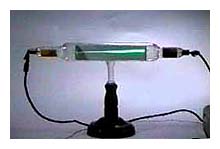Atomphysik
Atom - The Incredible World
 Welcome on
our interactive page dedicated to basic problems
in experimental atomic physics. This document is
meant for high-school students, who are
interested in physics, university students of
science departments, physics teachers and all who
would like to increase their knowledge of this
subject. Welcome on
our interactive page dedicated to basic problems
in experimental atomic physics. This document is
meant for high-school students, who are
interested in physics, university students of
science departments, physics teachers and all who
would like to increase their knowledge of this
subject.
On this page one can find full descriptions of
experiments in world's microstructure physics,
which supplied the knowledge of atomic structure
on the beginning of the 20th century, i.e.
discovery of electron, atomic nucleus and
calculation of an elementary charge. One can also
come across some other experiments which led to
detection of isotopes. These experiments are
presented from theoretical point of view (there
are mathematics formulas and transformations
presented in clear way) as well as practical
point of view (exact descriptions of sets of
instruments and of the way of carrying out the
experiments). Description of discoveries and
attainments in world's microstructure physic
accomplished throughout two thousand-year-old
history of this science development also takes
place here. It starts with ideas of Democritus, the Greek
philosopher, going on to the thoughts of other
atomic scientists of the 16th, 17th and 18th centuries, up to the
first half of the 19th century.
http://library.thinkquest.org/19662/low/eng/main.html
Modern Physics
The term modern physics often
finds students raising an eyebrow as they read
about experiments and discoveries that were
successfully completed nearly one hundred years
ago. The term was coined by physicists who saw in
the work of Thomson and Rutherford, of Planck and
Einstein, and a host of others a new physics
significantly different from the classical mechanics
of Newton, the electrodynamics of Maxwell, or the
conception of the atom espoused by Dalton.
What you will encounter at this site is an
extended history outlining the arguments to
support the existence of atoms. Following that
comes descriptions of what are called in physics
"classic experiments" the results of
which lend themselves to the modern explanation
of how nature seems to work.
http://www.wtvl.k12.me.us/wshs/physics361/moderniv/modhome.html
A Look Inside the Atom
 One hundred
years ago, amidst glowing glass tubes and the hum
of electricity, the British physicist J.J. Thomson was
venturing into the interior of the atom. At the
Cavendish Laboratory at Cambridge University,
Thomson was experimenting with currents of
electricity inside empty glass tubes. He was
investigating a long-standing puzzle known as "cathode rays." His
experiments prompted him to make a bold proposal:
these mysterious rays are streams of particles
much smaller than atoms, they are in fact
minuscule pieces of atoms. He called these
particles "corpuscles," and suggested
that they might make up all of the matter in
atoms. It was startling to imagine a particle
residing inside the atom--most people thought
that the atom was indivisible, the most
fundamental unit of matter. One hundred
years ago, amidst glowing glass tubes and the hum
of electricity, the British physicist J.J. Thomson was
venturing into the interior of the atom. At the
Cavendish Laboratory at Cambridge University,
Thomson was experimenting with currents of
electricity inside empty glass tubes. He was
investigating a long-standing puzzle known as "cathode rays." His
experiments prompted him to make a bold proposal:
these mysterious rays are streams of particles
much smaller than atoms, they are in fact
minuscule pieces of atoms. He called these
particles "corpuscles," and suggested
that they might make up all of the matter in
atoms. It was startling to imagine a particle
residing inside the atom--most people thought
that the atom was indivisible, the most
fundamental unit of matter.
http://www.aip.org/history/electron/jjhome.htm
The Discovery Of Radioactivity: The Dawn
of the Nuclear Age
Fran Slowiczek, Ed.D
and Pamela M. Peters, Ph.D.
 One hundred
years ago, a group of scientists unknowingly
ushered in the Atomic Age. Driven by curiosity,
these men and women explored the nature and
functioning of atoms. Their work initiated paths
of research which changed our understanding of
the building blocks of matter; their discoveries
prepared the way for development of new methods
and tools used to explore our origins, the
functioning of our bodies both in sickness and in
health, and much more. How did our conceptions of
atomic properties change? How has that change
affected our lives and our knowledge of the
world? One hundred
years ago, a group of scientists unknowingly
ushered in the Atomic Age. Driven by curiosity,
these men and women explored the nature and
functioning of atoms. Their work initiated paths
of research which changed our understanding of
the building blocks of matter; their discoveries
prepared the way for development of new methods
and tools used to explore our origins, the
functioning of our bodies both in sickness and in
health, and much more. How did our conceptions of
atomic properties change? How has that change
affected our lives and our knowledge of the
world?
http://www.accessexcellence.org/AE/AEC/CC/radioactivity.html
Radioactivity: Historical Figures
This article will focus on the
efforts of four scientists: Wilhelm Conrad
Roentgen, Antoine Henri Becquerel, Marie
Sklodowska Curie, and Ernest Rutherford. It
emphasizes their contributions to the elucidation
of radioactivity and the "key"
experiments they performed pertaining to their
discoveries.
http://www.accessexcellence.org/AE/AEC/CC/historical_background.html
Figures In Radiation History
Kurzbiographien der wichtigsten
Forscher auf dem Gebiet der Radioaktivität.
http://www.orcbs.msu.edu/radiation/radhistory/radfiguresmain.html
The
Electron Centennial Page
Janine Parker - janinetheraven@yahoo.com
More particle physics pages
Back
to Janine's Home Page
http://www.dpgraph.com/janine/electron.html
|



